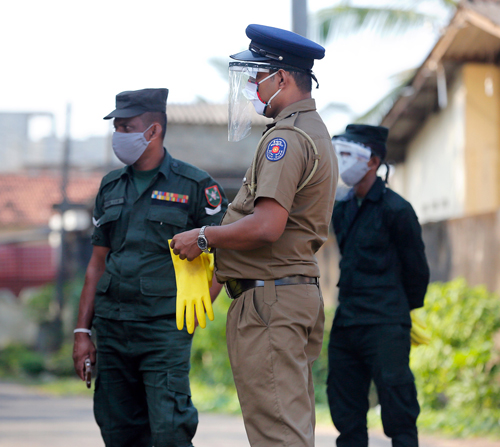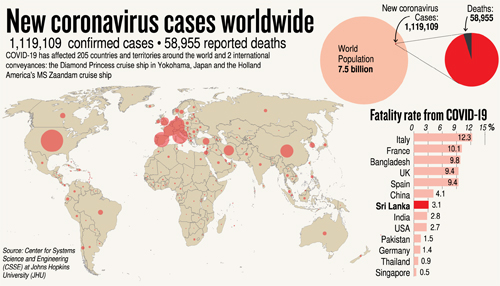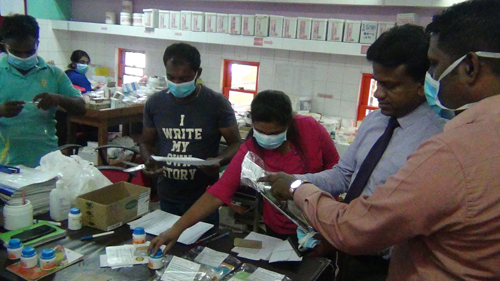News
Conduct testing to catch those affected by COVID-19

Sealed: Atalugama in Bandaragama. Pic by Sameera Weerasekara
Test, test and test,” is what we need, was the strong call which went out from many health sources, echoing the World Health Organization (WHO), as several lamented that Sri Lanka may not be having adequate resources to do so.
Coordinate laboratory testing including private sector support so that the Epidemiology Unit can strengthen its plan to identify all those infected by COVID-19, said a former Chief Epidemiologist, Dr. Nihal Abeysinghe, reiterating that each and every one who has arrived in the country during the past 14 days who has not been in quarantine should come forward and be able to get themselves tested from any centre free of charge. These people’s close contacts should also be tested.
“What we have to deal with is a new virus and the information with regard to it is changing daily. So we have to be vigilant,” said a source.
This was while there were also urgent calls from clinicians for all hospitals to build up capacity which should include structured ‘operational cells’ with a clear chain of command and specific responsibilities designated to each member.
 In another development, the Sunday Times learns that members of the Association of Medical Specialists (AMS) met Health Minister Pavithra Wanniarachchi; Health Ministry Secretary Bhadrani Jayawardena; Health Services Director-General Dr. Anil Jasinghe; and other health officials on Tuesday (March 31) to put forward some urgent proposals on how to handle this emergency caused by COVID-19.
In another development, the Sunday Times learns that members of the Association of Medical Specialists (AMS) met Health Minister Pavithra Wanniarachchi; Health Ministry Secretary Bhadrani Jayawardena; Health Services Director-General Dr. Anil Jasinghe; and other health officials on Tuesday (March 31) to put forward some urgent proposals on how to handle this emergency caused by COVID-19.
These include:
 Assuming that all respiratory cases are COVID-19, until proven otherwise.
Assuming that all respiratory cases are COVID-19, until proven otherwise.
Relaxing the criteria for testing and do more testing.
Having a dedicated Infectious Diseases Hospital (IDH) for each district, at least in high disease-prevalent districts for the moment, to prevent contamination of major hospitals. Then the major hospitals can send highly suspicious cases directly to these places.
All respiratory cases should be handled in a separate ward.
Providing an adequate number of face-masks and Personal Protective Equipment (PPE) to all hospitals to protect healthcare workers.
Introducing special insurance cover for healthcare workers engaged in the treatment of COVID-19 patients. This will give encouragement to them especially those in the lower grades.
Seeking the opinion of the relevant professional colleges when making clinical decisions. Eg. The expert opinion and involvement of the College of Anaesthesiologists with regard to care in Intensive Care Units (ICUs).

Puttalam - Drugs being packetted to deliver to patients. Pic by Hiran Priyankara
Seeking a new media mechanism where every news channel dedicates the first 5 minutes of its news bulletin to a government statement by a high-ranking health official on COVID-19 which includes the coronavirus status in Sri Lanka, the global situation, what is expected from the people in Sri Lanka and the government’s strategy to contain the virus.
Those who attended the meeting from the AMS were President Dr. Lalantha Ranasinghe, Secretary Dr. Asoka Gunaratne and members Dr. Sunil Wijayasinghe, Dr. Ravi Dayasena and Dr. LakKumar Fernando.
An AMS source said that they also discussed what measures could be taken to help medical postgraduate trainees who are currently in the United Kingdom but wish to come back to Sri Lanka due to the COVID-19 situation in that country.
| Guidelines in place to meet medical needs of expectant mothers, those with NCDs and cancer | |
| In the face of COVID-19, what are the medical facilities available for expectant mothers and patients including those with cancer or a non-communicable disease (NCD)?“We have issued guidelines with regard to expectant mothers,” said the Director of Maternal & Child Health, Family Health Bureau, Dr. Chithramalee de Silva, explaining that Public Health Midwives (PHMs) will carry out home visits and clinics will be held at Medical Officer of Health (MOH) level. All health personnel have been issued directions that if they come across expectant mothers with fever or flu-like symptoms, they should be referred to a specialization centre close-by, while precautions against COVID-19 are also detailed. These guidelines include referral criteria for specialized care – only high-risk mothers to be referred until further notice and routine referral for dating scans to be avoided until further notice. Some of the key messages to expectant mothers include – seeking medical advice through the telephone/mobile or PHM/MOH in case respiratory or obstetric problems arise; maintaining the Kick Count Chart (KKC – the number of times the baby moves per day in the womb) at home; and avoiding public gatherings including market places, supermarkets and public transport. With regard to diabetes and endocrine care, the advice from the College of Endocrinologists includes: all patients should continue their prescribed medications for diabetes (tablets/insulin). If unwell or suspected of having high or low sugar, they should contact their clinic/seek medical advice. Those with diabetes-related foot problems (new or worsening foot ulcer) should seek medical advice. “All pregnant mothers with diabetes and/or thyroid disorders should follow instructions given from the clinic,” said Dr. Noel Somasundaram giving a long list of do’s and don’ts issued to patients by the college in all three languages. He said that considering the safety of patients, they discourage routine diabetes and endocrine clinic visits until further notice. However, clinics may be contacted if further advice is needed. The college has made arrangements with Osu Salas and the Postal Department to deliver medication to patients on request, except insulin which should be collected from hospitals. This is because insulin needs to be kept under a certain temperature, he added. Meanwhile, with regard to cancer patients, a source at the National Cancer Institute (NCI), Maharagama, said planned chemotherapy and radiotherapy are being administered and the hospital will prioritise those scheduled for the next sessions depending on certain criteria such as whether treatment can be delayed and the type of cancer. Clinics and admissions are also taking place after triaging at the gate to ensure that no one with COVID-19 will come through, as it would result in the whole system being disrupted if a large number of healthcare staff have to be quarantined, the source said. Next week, the NCI is hoping to set up hotlines in each unit so that patients can call their specialists if they have any concerns and need reassurance. Many hospitals are taking extra precautions to prevent being hit by COVID-19. This is due to an exposure to someone with the virus resulting in whole wards having to close with all staff and patients needing quarantine. “This would have major repercussions on the health service,” a source said. This is why both state and private hospitals have set up a mechanism to screen any patient walking in. This is a triaging system using an extensive COVID-19 checklist, it is understood. This week some of the state hospitals affected by exposure to COVID-19 patients were the Negombo District General Hospital and the Colombo South (Kalubowila) Teaching Hospital; the semi-state Sri Jayewardenepura Hospital; and a private hospital in Negombo.
|
| Working round-the-clock on this national endeavour | |
| Assuring that they have not seen community transmission of COVID-19, the Chief Medical Officer of Health of the Colombo Municipal Council, Dr. Ruwan Wijayamuni said that there have only been 15 cases in their area.Of these 15, four were from the same house, two from another and three from a separate house, while the other six were from various parts of Colombo. “We have been able to trace from where they have got the disease and their main contacts,” he said, conceding that this is a tedious process as some people have 50-60 contacts. Currently, there are around 422 people quarantined in their homes. Citing the death of a COVID-19 patient a couple of hours after admission to hospital on April 1, Dr. Wijayamuni said that they got the information around 9 p.m. and went to his home immediately. The victim’s daughter, son-in-law and their two children were then sent to the National Institute of Infectious Diseases (NIID), where the son-in-law and one child tested positive. The other two family members were sent to a quarantine centre. Those who were in that block of flats where this family lived as well as three other flats have been evacuated to a quarantine centre because it would be easier to keep a check on their health, he said. With regard to contact tracing, Dr. Wijayamuni said that when a patient tests positive for the virus, they talk to him/her about the travel history of at least two weeks. If the patient is unable to communicate, they seek the support of the family. The other details they collect are from where they were, with whom they have associated and whether they have been at any large gatherings. “We get a list of phone numbers, compile a schematic contact tree and then talk to those people and fill any gaps or gray areas. These people are then instructed to undergo self-quarantine in their homes and if they are not within Colombo, the relevant Medical Officer of Health (MOH) in that area is informed,” he said. The data compiled by the Public Health Inspectors (PHIs) and MOHs are sent to the Epidemiology Unit and there is constant interaction among these groups, cross-checking the information, it is learnt. When asked about the staff, Dr. Wijayamuni said they were “overstretched” and “slowly burning out” because they have been on their feet from March 11, making it 22 long days. “We are taking all precautions not to get infected. We are working round-the-clock as this is a national endeavour. So far so good. The worry is if the cases go up any further.”
|
| Quarantine centres & sealed villages | |
Sri Lanka is in strict lockdown. While a majority of the people are in their own homes, some are in the ‘sealed’ villages of Akurana in Kandy, Kadayankulam in Puttalam and Atalugama in Kalutara and others in quarantine centres.As of Friday, there were nearly 1,800 in quarantine centres, while around 2,600 including 31 foreigners had left these centres after 14 days, the time of the incubation period of the new coronavirus.
Referring to the “alarming” increase in the number of infected, Army spokesman Brigadier Chandana Wickramasinghe said that the danger is not over yet and no decision has been taken to close the quarantine centres. With regard to foreigners who leave these centres, he added that even though the airport is open for departures, they are opting to stay in Sri Lanka as they believe it is one of the safest countries. As such, they are taken to whatever place they have arranged to stay at. Referring to foreigners, the Air Force’s Acting Director (Media), Group Captain Dushan Wijesinghe said that at their quarantine centres there were only a Sri Lankan with a British passport and his Filipino wife. They were taken to the man’s family home.
|
| Innovations in the pipeline | |
Many people have come up with innovations in the light of medical equipment needed urgently in Sri Lanka.
In Kandy, Nurse Bihan Haputhanthri (42) attached to the Cardiothoracic ICU of the National Hospital there has invented a unit that can be fixed to a ventilator, so that four patients can be put on the ventilator simultaneously. “There are only about 500 ventilators in Sri Lanka. If the unit I have invented is used on these 500 ventilators, 2,000 people can be on oxygen at the same time,” he said, explaining that the simple requirements are filters and tubes. The imports needed would be two types of filters – bacteria filter and virus filter – and not ventilators. While the cost of a ventilator is between Rs. 300,000-500,000, the filter and tube needed for each patient would cost only Rs. 7,500-10,000, according to Bihan who has a model awaiting patenting. He is also seeking approval from medical specialists including anaesthetists. Bihan was appreciative of the support extended for his work by Kandy Hospital Director Dr. Saman Ratnayake and fellow nurses.
The digital printing outfit ‘Anim8’ is making visors for the use of healthcare staff treating COVID-19 patients. Anim8 is utilizing a robotic cutting machine and a laser engraver marker to make these visors. It is hoping to release this design for open-source manufacture shortly.
A mechatronics student, P.D.S. Ashan Kumara, of the Faculty of Technology, University of Sri Jayewardenepura, has developed a prototype ventilator that works on pressure controlled respiration mode.
|


